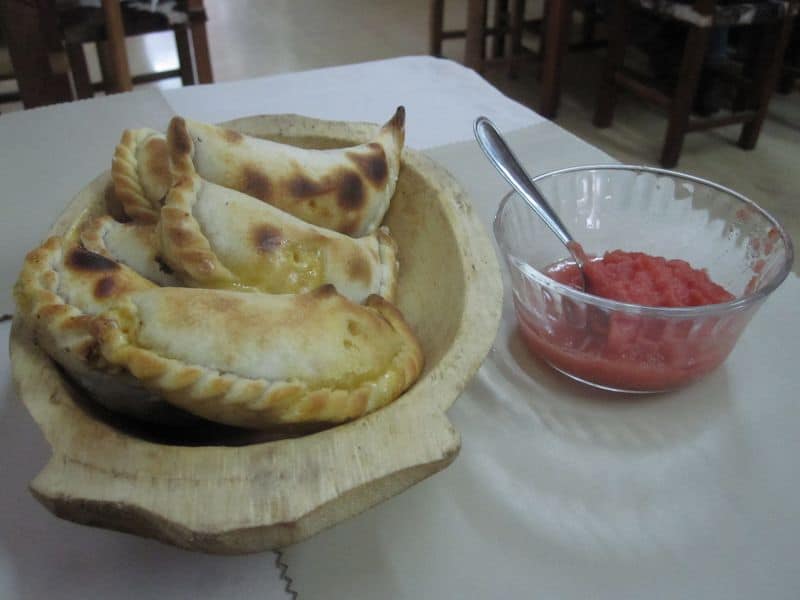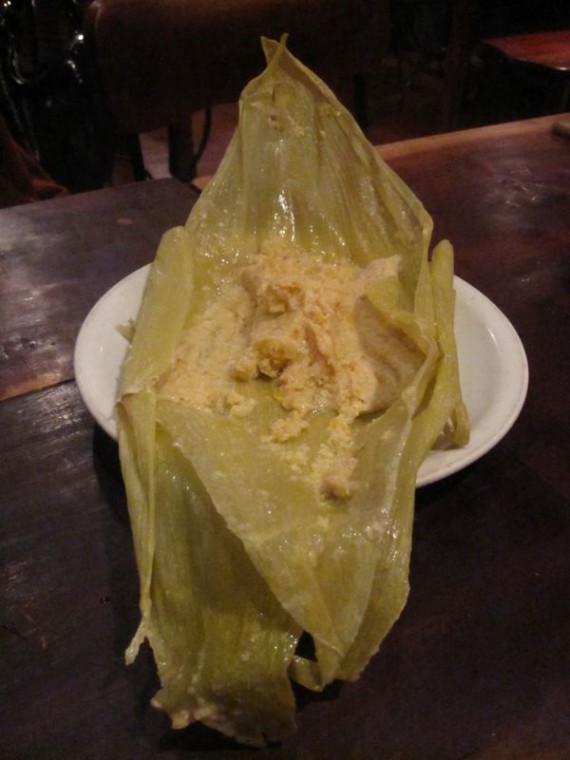This page contains affiliate links. Please read our disclosure for more info.
We had been warned that Argentina would be a difficult travel destination for vegetarians – it’s the home of the steak after all. After spending two months in Buenos Aires though we didn’t see what the problem was – we ate at lots of amazing vegetarian restaurants and wrote about the top 10 foods we enjoyed that weren’t steak.
Buenos Aires, however, is not the rest of Argentina. After leaving the capital we travelled to Puerto Iguazú before spending a few months in the Salta region in the northwest. After a week of road tripping around the area we were desperate for our own kitchen. Every day we were forced to eat a diet of medialunas, empanadas and either pizza or pasta for dinner. Worst of all, unlike in the capital, the pasta wasn’t even any good. We craved healthy food after consisting on this stodgy diet. Renting an apartment in Salta was wonderful as we were finally able to take advantage of the excellent vegetable market and cook our own meals.
That said, the vegetarian eating options in Argentina are much better than in neighbouring Paraguay. You’ll survive here, as we always do, and if you are lucky enjoy some meals along the way. Here’s what you are likely to be eating:
Medialunas
Breakfast in hostels and hotels is invariably medialunas (croissants) and coffee. They can be tasty but aren’t the most nutritious or filling start to the day. Every American we met dreamt of opening a breakfast restaurant as they longed for eggs, which are never served in the mornings. In more expensive hotels you may get some fruit and cereal to go with your pastries, if you’re lucky.
Empanadas
Empanadas in the northwest are renowned for being the best in the country, and we did find them tastier than in Buenos Aires, although that could be because we’d just come from the veggie wasteland that is Paraguay. There are less varieties of these savoury pastries up north though: you’ll invariably find carne (beef), pollo (chicken) and queso (cheese), so obviously we stuck to the cheese ones and had them often for a cheap lunch. Sometimes they throw in extra fillings along with the cheese like egg or potato, but these are never advertised on the menu – luckily the surprise ingredient was never meat.
Excitingly, in the north empanadas are usually served with aji, a chili and tomato spicy dip (see top photo). Well, it’s as spicy as anything ever gets in Argentina.
If you visit Cafayate be sure to visit La Casa de Las Empanadas, just off the main plaza, which has lots of interesting vegetarian flavours packed full with vegetables.
We do love empanadas, but got sick of eating them every day for a week.
Humitas
Another traditional, tasty and vegetarian friendly dish that is commonly found in the northwest is humita, dating back from pre-Hispanic times.
Fresh corn and cheese are mixed together with onion to form a big mush which is served wrapped up in a corn husk and boiled. Unwrap your parcel and don’t eat the husk!
Avoid tamales which are like humitas but contain meat.
Vegetarian Locro?
Locro is a popular local stew made with corn, beans, vegetables and usually meat. Apparently you can get a vegetarian version but we never managed to find one, which is a shame as it looked like it could be delicious. Let us know if you had any luck with this.
Quinoa
Quinoa is a grain-like food that is very nutritious and high in protein, and was sacred to the Incas. As it originates from the Andean region of South America we found it became quite common on menus when we visited the higher altitude towns of Cachi and Purmamarca. The quinoa dishes are sometimes vegetarian friendly so look out for it. Our quinoa stuffed pumpkin made a welcome change to pasta.
Pasta
As with Buenos Aires the Italian influence is still strong in the rest of the country and pasta will always be an option, even in parilla (barbeque) restaurants. There is usually a choice of pastas and sauces with the vegetarian options being tomato, cheese and sometimes pesto. Unfortunately we didn’t find it of very good quality outside of the capital, as it was usually too stodgy. I also once found meat in my spinach and ricotta ravioli, even though the waiter had told me it didn’t contain any. Still, pasta makes a filling meal (two can probably share one portion) and can be found everywhere.
Pizza
Like pasta, pizza is easily found with vegetarian toppings but the quality isn’t usually great with thick bases and too much cheese.
Self-Cater
If you want to eat healthily, and are tired of the boring salads found in restaurants, self catering is really your best option. The market in Salta is excellent with a wide range of fruit and vegetables as well as dried beans, lentils and spices.
Salta Vegetarian Restaurant
Annoyingly Entre Indyas, a supposedly good vegetarian restaurant closed down just before we got to Salta. The only other vegetarian restaurant is Bios Diet (General Güermes y Pueyrredón) which serves rather bland, uninventive, but thankfully healthy vegetarian food such as soy burgers. There’s a daily special every lunch time plus a salad bar. In the evenings they only serve salad and quiche.
Learn Some Spanish
As with Paraguay your life will be easier if you can speak some Spanish to explain your eating requirements and check if a meal contains meat. A useful phrase to know is “Soy vegetariano/a” (I’m a vegetarian), although it is better to be more specific: “No como carne, pescado ni pollo” (I don’t eat meat, fish or chicken).
Eat Late
This isn’t a vegetarian specific tip but it’s important to remember that Argentines don’t eat dinner until late – 10pm is normal and most restaurants aren’t open before 8 or 9 pm.
Head to Buenos Aires
If you are travelling around Argentina and are desperate for a good meal then head to the capital. Check out our tips for the best vegetarian friendly restaraunts in Buenos Aires.
Please bear in mind that these vegetarian travel tips are based on our experiences in northwest Argentina. If you have found the situation different in other parts of the country please let us know.
If you are travelling as a vegetarian around South America you can also read our survival guides to Brazil and Paraguay.




Ojo: in the North most empanadas and breads are made with grasa de vaca – that’s cow fat. Learn to say ¿es hecho con grasa de vaca? Sitting in a café in Salta right now, just got back from Purmamarca & Tilcara. I hope to have some blog posts up soon. ¡Viva la Argentina!
Mmm … I’m not looking forward to Argentina for this reason, while my steak loving other half can`t wait! I looked on your website today hoping that you`d had a better experience! I might just drink wine! I had vefetarian Locro in Bolivia and it was delicious. It was part of a special Easter Friday meal, which was 12 dishes to represent the 12 disciples. All dishes were either veggie or pescatarian friendly. Yummy. I saw humitas in Bolivia, but was too busy scoffing on papas rellenas to try them. Might try them in Argentina now! Thanks for the useful post!
I am going in august to spend a year in Argentina as a exchange student. It is reasuring to see that it is possible to remain vegetarian, but I am concerned with existing on these few foods for an entire year. I am staying with a host family and I’m concerned that they may find it a hassel to accomodate my dietary restrictions. I am willing to eat meat if I really need to and I’ve only newly become vegetarian and come from a meat eating family so it wouldn’t be a big deal if I had to give it up for a bit, but I’d really like to continue to be vegetarian but still experience the culture. I also enjoy cooking for myself as long as there are places I can find the ingredients. I imagine it really depends on where in Argentina I am and I don’t quite know what area I will be staying, so I guess i’ll cross that bridge when I come to it!
Good morning in argentina, we have two vegetarian lodges, it is really interesting to know. I’m from argentina and i have bornt vegetarian, i don’t know meat flavour.
I would love if you write me to my email, we need to talk :).
Bye take care i hope your reply as soon as possible, i hope you had liked argentina :).
The restaurant Cimichurri in NYC serves a smashing vegetarian locro, and I think you should apply yourselves to extracting a recipe from BA to post here: traditional ingredients include white corn kernels, white beans, cubed pork, stewing beef, pancetta or sausage, carrots, squash, potatoes and sweet potatoes. The sauce includes cumin and paprika, apparently. I didn’t miss the meat at all, and this one had hominy as well as corn, and barley too. I’m sure there’s an existing recipe that’s easy enough to adapt.
This is good info as we are thinking of a trip to Argentina, thanks. But, tried Googling, but did not get a definition for ‘vaccine fat’ or ‘grasa vacuna’ – Is it lard?
Enjoy your travels.
It’s cow fat.
We are traveling to Argentina in dec. we are complete vegetrians. We don’t eat eggs too, after reading on internet seems really difficult to find veg food…
Uhhhhhhmmmm La Selecta is awesome! It’s true, everything there is very tasty. I miss that place in Salta!
Another vegetarian here… and we are heading to Argentina next year. So yay for easy to find veg options in Argentina…
Well, it’s easy in Buenos Aires but it does get boring elsewhere.
As a vegetarian, I always appreciate a vegetarian guide! Thanks for the tips!
Glad you found it useful. Bolivia will be coming next (once we get there!).
I do think it’s important to point out that pretty much every every restaurant we’ve been to does salad – it might not be that interesting but it’s there. We’ve made some pretty tasty meals by ordering salad, eggs, puré de papas and puré de calabaza but otherwise you’re pretty much spot on – and a steady diet of pasta, pizza and empanadas gets old pretty quickly!! The restaurant La Selecta on the main plaza in Salta does hummus, tabule, an aubergine dip and “arabic” empanadas filled with spinach – it may not be authentic but it’s pretty tasty and makes a great change!!
That is true – salad can be found everywhere, but outside of BA we did find it really boring. Also, we wanted something hot on the chilly nights, but combining it with other things is a good idea. I can’t believe we missed La Selecta! It sounds great.
We will make use of your post when we get to Argentina in a few months – Humitas sound interesting! Will definitely try them. Self-catering is probably the healthiest option, and we’re looking forward to having our own kitchen for a while after surviving on cheese sandwiches and pizza in the last few weeks.
Humitas are definitely worth a try and make a change from empanadas. Luckily they are found everywhere in the northwest so it’s good to know we’ll never starve. Having a kitchen is wonderful after a boring and unhealthy diet.
Very nice information! I just wanted to add that it is important to note that most of the cakes, croissants, pies, biscuits (pastry in general) made in Argentina and Uruguay include among their ingredients vaccine fat, as it is cheaper in comparison with margarine, given the magnitude of the meat industry in the area. Margarine is hard to find in some places, and ironically, sometimes when you find a 100% vegetable one it includes something they call “natural flavor” in order to resemble the traditional (animal) one. By the other hand, some products considered vegetarian like soy burgers or soy “milanesas” may include vaccine fat as well. I assume that it’s almost impossible knowing all the ingredients of a meal when eating out, but at least when self catering I try to read the ingredients and avoid products that contain “grasa vacuna”
We try not to think about things like this as otherwise we wouldn’t eat! We do check the packages when self catering though and found it surprisingly difficult to find vegetable stock cubes without grasa vacuna – the Maggi brand in yellow packaging is OK though.
Love this post, as much as I love meat I really look forward to veggie-based meals. Tonight for dinner in Ecuador I went for Chinese so I could eat a plate of broccoli.
Thanks Ayngelina. Argentina is not the best place for vegetables but at least you can enjoy the meat. Huge plates of it! Read Uncornered Market’s post for a food overview which includes meat options: http://www.uncorneredmarket.com/2010/08/argentine-food-steak-empanadas-pizza-pasta/
I’m not noticing a lot of vegetables showing up here :) While it is possible to get by in Argentina as a vegetarians, I imagine empanadas, pasta and pizza does get old after a while. This is where self-catering and cooking can save the day.
The market in Salta is a lot of fun, isn’t it? It reminded me of Bolivia in terms of variety of chili peppers and spices and vegetables.
I know, it’s not the most healthy list! It was such a relief when we were able to start cooking for ourselves. Glad to hear that Bolivian markets are as good. I have heard great things about the fruit and cheap juices so really looking forward to that.